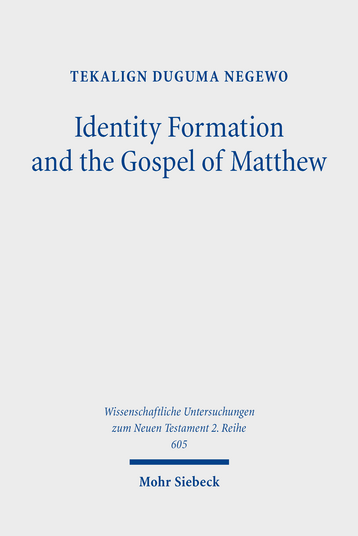Theology
Tekalign Duguma Negewo
Identity Formation and the Gospel of Matthew
A Socio-Narrative Reading
[Identitätsbildung und das Matthäusevangelium. Eine sozio-narrative Lektüre.]
84,00 €
including VAT
including VAT
sewn paper
ISBN 978-3-16-161788-1
available
Also Available As:
Published in English.
Why does the author of the Gospel of Matthew include non-Judean characters in his narrative? Tekalign Duguma Negewo attempts to answer this question based on the assumption that Matthew's Gospel played an identity-forming role for its community. As a heuristic interpretive tool, he uses the socio-narrative reading method, which merges socio-scientific criticism, narrative criticism, and semiological reading through social identity, narrative, and semiotic theories. Tekalign Duguma Negewo argues that the implied author used the non-Judean characters to form the identity of the ideal readers' community.Survey of contents
Introduction: The Identity-Forming Role of Matthew's GospelChapter 1: History of Research
1.1. History of Research on Identity Formation and Matthew's Gospel – 1.2 History of Research on the Matthean Community – 1.2.1 Historical-Critical Method – 1.2.2 Literary Criticism – 1.3 History of Research on the Function of Matthew's Gospel – 1.4 The Gospel of Matthew and Non-Judeans – 1.5 The Need for an Integrative Approach – 1.6 Conclusion
Chapter 2: Socio-Narrative Reading of the Gospels
2.1 Previous Attempts to Merge Reading Methods – 2.1.1 Merging Different Reading Methods – 2.1.2 Barthes' Semiological Reading and Gospel Studies – 2.1.3 Conclusion – 2.2 The Way Forward: A Socio-Narrative Reading of Matthew – 2.2.1 Semiological Analysis: Matthean Narrative as Myth – 2.2.2 Mythmaking and Social Identity Formation – 2.2.3 Narrative Criticism – 2.2.4 »Us« vs »Others« in Matthew – 2.3 Conclusion
Chapter 3: Negatively Stereotyped Non-Judeans in the Matthean Narrative
3.1 Negatively Stereotyped Non-Judeans in Jesus' Teaching – 3.1.1 The Meaning of Ἰουδαῖοι and ἔθνη/ἐθνικοί in the First Century – 3.1.2 The Boundary between Non-Judeans and the Matthean Community – 3.1.3 Conclusion – 3.2 Negatively Stereotyped Non-Judean Individuals in Matthew – 3.2.1 The Gadarenes (Matt. 8:28–34) – 3.2.2 Pilate (Matt. 27:1–26 and 27:62–66) – 3.2.3 The Roman Soldiers (Matt. 27:27 – 28:15) – 3.3 Conclusion
Chapter 4: Non-Judeans in Matthew's Genealogy
4.1 The Function of Genealogy in the Ancient World – 4.2 Judean Identity Construction in the Light of »Others« – 4.2.1 Purity/Impurity of Non-Judeans and Their Identity – 4.2.2 Assimilation of Non-Judeans through Intermarriage – 4.2.3 Reinterpretation of the Torah as a Boundary Marker for Judeans – 4.3 Assimilation of Non-Judeans through Marriage – 4.3.1 Tamar – 4.3.2 Rahab – 4.3.3 Ruth – 4.3.4 The Wife of Uriah – 4.3.5 Conclusion – 4.4 Being People of God – 4.4.1. Divine Identity vs Genealogical Purity – 4.4.2 Jesus and »His Brothers« as the Reconstituted or Restored Israel – 4.5 Semiological Analysis of the Four Non-Judeans – 4.5.1 The First Semiological Order – 4.5.2 The Second Semiological Order – 4.6 The Four Non-Judeans and Their Role in Identity Formation – 4.7 Conclusion
Chapter 5: The Magi as Representative Non-Judeans
5.1 The Identity of the Magi: Judeans or Non-Judeans? – 5.2 The Characterisation of the Magi – 5.3 The Role of the Magi as Representative Non-Judeans – 5.4 The Significance of the Magi: A Semiological Reading – 5.4.1 Cultural and Theological Background of the Magi – 5.4.2 The Coming of the Judean King: Implications for Non-Judeans – 5.4.3 A Semiological Analysis of Matthew 2:1–12 – 5.5 The Role of the Magi in Identity Formation – 5.6 Conclusion
Chapter 6: The Healing of the Centurion's Servant
6.1 Matthean Characterisation of the Roman Centurion – 6.2 Narrative Placement of the Centurion Narrative – 6.3 Non-Judean Participation in Messianic Blessings – 6.3.1 Semiological Reading of the Centurion Story – 6.3.2 The Role of the Centurion Story – 6.3.3 Non-Judean Participation in Messianic Blessings – 6.4 Conclusion
Chapter 7: The Healing of the Canaanite Woman's Daughter
7.1 The Otherness of the Canaanite Woman – 7.2 Positive Characterisation of the Canaanite Woman – 7.3 Non-Judeans in the Promise of Israel's Restoration – 7.4 The Canaanite Woman as Representative of Non-Judeans – 7.4.1 Semiological Reading of the Story of the Canaanite Woman – 7.4.2 The Role of the Story of the Canaanite Woman – 7.5 Conclusion
Chapter 8: Summary and Recommendation
